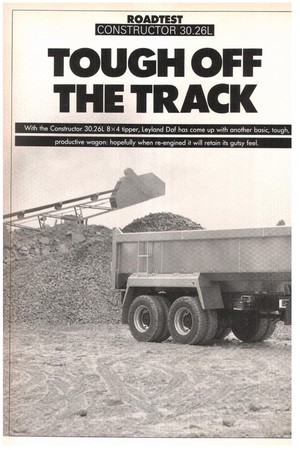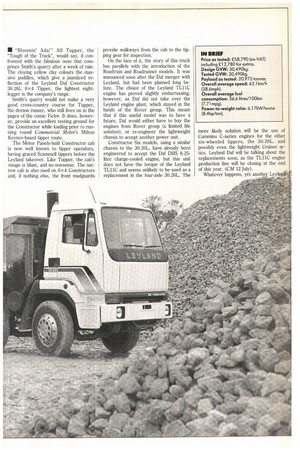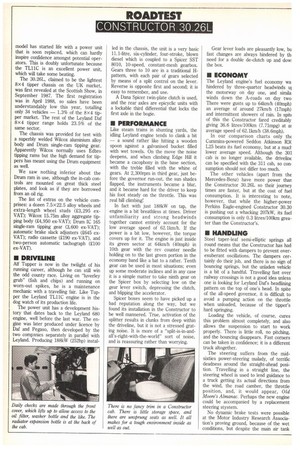TOUGH OFF THE TRACK
Page 32

Page 33

Page 34

Page 35

If you've noticed an error in this article please click here to report it so we can fix it.
With the Constructor 30.26L 8x4 tipper, Leyland Daf has come up with another basic, tough, productive wagon: hopefully when re-engined it will retain its gutsy feel.
• "Bloomin' Ada!" Alf Tupper, the "Tough of the Track", would say, if confronted with the fabulous ooze that comprises Smith's quarry after a week of rain. The cloying yellow clay colours the massive puddles, which give a jaundiced reflection of the Leyland Daf Constructor 30.26L 8x4 Tipper, the lightest eightlegger in the company's range.
Smith's quarry would not make a very good cross-country course for Tupper, the demon runner, who still lives on in the pages of the conic Victor. It does, however, provide an excellent testing ground for the Constructor while loading prior to running round Commercial Motor's Milton Keynes-based tipper route.
The Motor Panels-built Constructor cab is now well known to tipper operators, having graced Scammeli tippers before the Leyland takeover. Like Tupper, the cab's visage is blunt, and no-nonsense. The narrow cab is also used on 6x4 Constructors and, if nothing else, the front mudguards provide walkways from the cab to the tipping gear for inspection.
On the face of it, the story of this truck has parallels with the introduction of the Roadtrain and Roadrunner models. It was announced soon after the Oaf merger with Leyland, but had been planned long before. The choice of the Leyland TL11C engine has proved slightly embarrassing, however, as Daf did not take over the Leyland engine plant, which stayed in the hands of the Rover group. This meant that if this useful model was to have a future, Daf would either have to buy the engines from Rover group (a limited life solution), or re-engineer the lightweight chassis to accept another power unit.
Constructor Six models, using a similar chassis to the 30.26L, have already been engineered to accept the Daf DHS 8.25litre charge-cooled engine, but this unit does not have the torque of the Leyland TL11C and seems unlikely to be used as a replacement in the four-axle 30.26L. The more likely solution will be the use of Cummins C-series engines for the other six-wheeled tippers, the 30:26L, and possibly even the lightweight Cruiser artics. Leyland Daf will be talking about the replacements soon, as the TLIIC engine production line will be closing at the end of this year. (CM 12 July).
Whatever happens, yet another Ley model has started life with a power unit that is soon replaced, which can hardly inspire confidence amongst potential operators. This is doubly unfortunate because the TL11C is an excellent power unit, which will take some beating.
The 30.26L, claimed to be the lightest 8x4 tipper chassis on the UK market, was first revealed at the Scottish Show, in September 1987. The first registration was in April 1988, so sales have been understandably low this year, totalling only 34 vehicles — 1.3% of the 8x4 tipper market. The rest of the Leyland Daf 8x4 tipper range holds 23.5% of the same sector.
The chassis was provided for test with a superbly welded Wilcox aluminium alloy body and Drum single-ram tipping gear. Apparently Wilcox normally uses Edbro tipping rams but the high demand for tippers has meant using the Drum equipment as well.
We saw nothing inferior about the Drum ram in use, although the in-cab controls are mounted on great thick steel plates, and look as if they are borrowed from an oil rig.
The list of extras on the vehicle cornprises: a dozen 7,5x22.5 alloy wheels and extra-length wheel studs (23,295 exVAT); Wilcox 15.75m alloy aggregate tipping body (£4,950 ex-VAT); Drum IC 165 single-ram tipping gear (3,600 ex-VAT); automatic brake slack adjusters (£645 exVAT); radio cassette (2190 ex-VAT), and two-person automatic tachograph (£100 ex-VAT).
• DRIVELINE
All Tupper is now in the twilight of his running career, although he can still win the odd county race. Living on "luverley grub" (fish and chips) and running on worn-out spikes, he is a maintenance mechanic with a travelling fair. Like Tupper the Leyland TLI1C engine is in the dog watch of its production life.
The power unit has a development history that dates back to the Leyland 680 engine, well before the last war. The engine was later produced under licence by Daf and Pegaso, then developed by the two companies separately in parallel with Leyland. Producing 188kW (252hp) instal led in the chassis, the unit is a very basic 11.1-litre, six-cylinder, four-stroke, blown diesel which is coupled to a Spicer SST 8010, 10-speed, constant-mesh gearbox. Gears three to 10 are in a traditional Hpattern, with each pair of gears selected by means of a split control on the lever. Reverse is opposite first and second; it is easy to remember, and use.
A Dana Spicer twin-plate clutch is used, and the rear axles are epicyclic units with a lockable third differential that locks the first axle in the bogie.
• PERFORMANCE
Like steam trains in shunting yards, the idling Leyland engine tends to clank a bit — a sound rather like hitting a wooden spoon against a galvanised bucket filled with wet towels. On the move the noise deepens, and when climbing Edge Hill it became a cacophony in the base section, with the treble filled with the whine of gears. At 2,300rpm in third gear, just before the governor run-out, the sun shades flapped, the instruments became a blur, and it became hard for the driver to keep his foot steady on the throttle. This was real hill climbing!
In fact with just 188kW on tap, the engine is a bit breathless at times. Driver unfamiliarity and strong headwinds together cannot entirely account for the low average speed of 62.11cm/h. If the power is a bit low, however, the torque covers up for it. The engine is just inside its green sector at 641cm/h (40mph) in 10th gear with the rev counter needle holding on to the last green portion in the economy band like a bat to a rafter. Tenth gear can be used in most situations; even up some moderate inclines and in any case it is a simple matter to take ninth gear on the Spicer box by selecting low on the gear lever switch, depressing the clutch, and blipping the accelerator.
Spicer boxes seem to have picked up a bad reputation along the way, but we found its installation in the Constructor to be well mannered. True, activation of the splitter results in clunks from deep within the driveline, but it is not a stressed grating noise. It is more of a "split-is-in-andall's-right-with-the-world" sort of noise, and is reassuring rather than worrying. Gear lever loads are pleasantly low, bu fast changes are always hindered by th need for a double de-clutch up and dow the box.
• ECONOMY
The Leyland engine's fuel economy wa. hindered by three-quarter headwinds ui the motorway on day one, and simila winds down the A-roads on day two There were gusts up to 641cm/h (40mph) an average of around 271cm/h (17mph) and intermittent showers of rain. In spitt of this the Constructor fared creditably giving 36.6 litres/100km (7.71mpg) at al average speed of 62.11(m/h (38.6mph).
In our comparison charts only tht Cummins-powered Seddon Atkinson R3( L25 beats its fuel economy, but at a mud lower average speed. Although the 307 cab is no longer available, the drivelinE can be specified with the 311 cab, so consumption should not differ too much.
The other vehicles (apart from the Mercedes-Benz) have more power than the Constructor 30.26L so their journey times are faster, but at the cost of fuel consumption. It is interesting to note, however, that while the higher-power Perkins Eagle-engined Constructor 30.30 is pushing out a whacking 207kW, its fuel consumption is only 0.3 litres/1001cm greater than the Constructor's.
• IIANDLING
Steel taper-leaf semi-elliptic springs all round means that the Constructor has had to be fitted with dampers to prevent overexuberant oscillations. The dampers certainly do their job, and there is no sign of bouncing springs, but the unladen vehicle is a bit of a handful. Travelling fast over railway crossings is not a good idea unless one is looking for Leyland Dafs headlining pattern on the top of one's head. In spite of the all-speed governor, it is difficult to avoid a pumping action on the throttle when unloaded, because of the tipper's hard springing.
Loading the vehicle, of course, cures this problem almost completely, and also allows the suspension to start to work properly. There is little roll, no pitching, and the bouncing disappears. Fast corners can be taken in confidence; it is a different truck altogether.
The steering suffers from the midsixties power-steering malady, of terrific deadness around the straight-ahead position. Travelling in a straight line, the steering wheel is used to lend guidance to a truck getting its actual directions from the wind, the road camber, the throttle position, and, it would appear, Old Moore's Almanac. Perhaps the new engine could be accompanied by a replacement steering stystem.
No dynamic brake tests were possible at the Motor Industry Research Association's proving ground, because of the wet conditions, but despite the main air tank -tinning a bit low on pressure, braking ?ificiencies are good. When running unaden the brakes needed a gentle touch, )ut no more so than other unladen trucks, incl the stopping is positive and progressive when laden.
The only problem we had with the test truck was a seized piston in the differential locking mechanism, which left the lock ..ngaged. Daf Aid mechanics got out to us within 45 minutes, but had to disarm the switch as they had no replacements with them.
The Constructor cab is clearly designed to suit a harsh working environment, with unsprung seats, a spartan dashboard, and plastic covering everything for ease of cleaning. Even the window winders have an economy-pack feel about them, being stiff to operate. There is little room in the cab, especially for driver's notes, although there is a large lockable glove box for storing running sheets, sandwiches, and the like. The long shelf above the windscreen is unsuitable for storing anything loose as cornering shifts items from one side to the other with unseen clunks.
Most annoying of all is the fascia itself, with all the instruments under thick glass. If God had meant all of a vehicle's instruments to be grouped together under the same piece of highly relective glass he would have given us polarised eyes to see them with_ Our other quarrel with the fascia concerns the units of calibration used for the air pressure gauges_ What are KPa? The concensus at Commercial Motor is that they are Kilo Pascals, and are pretty silly units of measurement when most of us use Bar or PSI.
• SUMMARY
Despite its various financial beatings in the past, Leyland Trucks never quite lost the knack of producing tough, no-frills productive vehicles. With the TL11C engine the Constructor is slightly underpowered, but like the best of British underdogs (Alf Tupper included), it has plenty of heart.
In the case of this tipper that heart takes the form of considerable reserves of tor que, which the Daf equivalent simply cannot match. Leyland Daf will have already made the decision on the engine's replacement, and we can only hope that its decision has been a wise one.
The 30.26L has an excellent payload at 20.975 tonnes, and is reasonably priced at 46,010 ex-VAT. Economy from the TL11C is not brilliant, weather notwith standing, but although the Perkins unit in the Constructor 30:30 is probably more efficient, the old Leyland engine should clank its way along earning a steady income for any operator. The all-steel suspension is not the most advanced on the market but it gives a reasonable ride and is simple to maintain and repair.
The cab is cramped and spartan, and the instrument choice is an accountant's rather than an operator's dream, but then again, sprung seats, and fancy trims don't win races, as Tupper might say.
0 by Andrew English


















































































